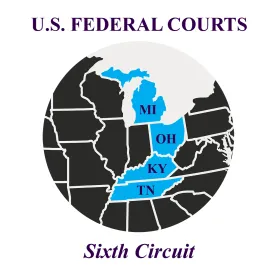n a rare victory for employers that participate in multiemployer pension plans, the Sixth Circuit Court of Appeals held that the interest rate memorialized in the Segal Blend actuarial assumption was inappropriate to use in a withdrawal liability calculation because it is not based on “anticipated experience under the plan.” While likely to be further challenged, the September 28, 2021, opinion in Sofco Erectors, Inc. v. Trustees of the Ohio Operating Engineers Pension Fund, may provide significant leverage to employers in challenging—and settling—withdrawal liability assessments, especially for employers and/or multiemployer pension plans subject to the jurisdiction of the Sixth Circuit Court of Appeals (which covers Kentucky, Michigan, Ohio, and Tennessee).
Calculating Withdrawal Liability
Withdrawal liability is an exit fee imposed under the Employee Retirement Income Security Act (ERISA) when an employer withdraws (completely or partially) from a multiemployer pension plan that is underfunded. A key factor in calculating the amount of withdrawal liability allocable to a withdrawn employer is the interest rate assumption, used to project the pension plan’s liabilities (i.e., promised benefits); the lower the interest rate, the higher the underfunding—and the withdrawal liability allocable to the withdrawn employer.
ERISA generally provides broad discretion to the pension plan’s actuary, when calculating withdrawal liability, to select the interest rate based on its best estimate of the anticipated experience. Generally, the possible options for selecting an interest rate range from, at one end, the pension plan’s assumed interest rate for minimum funding purposes (often in the 5-7 percent range) to the interest rate published by the Pension Benefit Guaranty Corporation (PBGC) applied upon a termination of the pension plan by mass withdrawal (currently approximately 2 percent).
The Segal Blend is a weighted blend of the interest rates sitting at opposite ends of this interest rate range: the funding rate and the PBGC termination (annuity) rates. The Segal Blend, as its name implies, is primarily used by actuaries employed by The Segal Group, Inc., which serves as the plan actuary for over 300 multiemployer pension plans.
Employers have challenged use of the Segal Blend, especially in recent years when the low PBGC termination rates have meant the Segal Blend is much lower than the funding rate. Litigation over use of the Segal Blend has resulted in a split at the district court level: district courts in the Second and Sixth circuits ruled in favor of employers, while district courts in the Third and D.C. circuits have upheld use of the Segal Blend. These district court cases were settled by the parties before reaching any formal decision on appeal. As a result, the Sixth Circuit’s ruling in Sofco is the first proclamation on the propriety of the use of the Segal Blend at the Court of Appeals circuit-level.
The Sixth Circuit’s Decision
The Sixth Circuit concluded that the Segal Blend could not possibly be the plan actuary’s best estimate of anticipated experience because this methodology “dilutes” the best estimate with interest rates—mass withdrawal termination rates—that might never apply. In so concluding, the Sixth Circuit noted that any deference owed to the plan actuary cannot excuse the explicit requirement in ERISA that requires the actuary to use actuarial assumptions and methods based on “anticipated experience.” The Sixth Circuit also found irrelevant both the widespread use of this approach as an “accepted actuarial practice” and any “laudable policy proposal” that use of the Segal Blend might achieve if such policy was not supported by congressional intent.
Notably, the Sixth Circuit refrained from deciding whether the plan actuary may use one interest rate for minimum funding purposes (a rate that’s controlled by ERISA) and another to calculate withdrawal liability. So, even if the Segal Blend may not be used, a plan actuary may attempt to justify use of an interest rate other (and lower) than the funding rate. In a footnote, the Sixth Circuit also implied that the PBGC could explicitly authorize use of the Segal Blend and thereby “displace” the ERISA requirement by regulation.
Key Takeaways
As a practical matter, Sofco outlines issues that any employer that faces the prospect of withdrawal liability may want to explore—especially with regard to the interest rate used in a withdrawal liability calculation. If Sofco remains the final proclamation, plan actuaries in the Sixth Circuit that use the Segal Blend may need to redetermine the appropriate interest rate in light of the Sixth Circuit’s affirmation of the best estimate standard based on anticipated experience rather than a one-size-fits-all Segal Blend approach.
The Sofco decision potentially has broad significance: employers in any jurisdiction—not just the Sixth Circuit—may want to consider the holding in Sofco when deciding how to respond to a withdrawal liability assessment. If Sofco stands, any pension plan’s use of the Segal Blend in withdrawal liability calculations may affect the accuracy of pre-withdrawal estimates, the amount of withdrawal liability assessed, the posture of any settlement negotiations and arbitration proceedings and even the efficacy of any previous settlement agreements entered into with the pension plan. There may be other nuances to the withdrawal liability calculation that may render the Segal Blend interest rate issue moot (e.g., reduction under the 20-year cap on installment payments or circumstances in which the interest rate used is lower than the Segal Blend interest rate).
Even if a pension plan doesn’t use the Segal Blend, the Sixth Circuit’s opinion may undermine other actuarial approaches (e.g., using only PBGC termination rates). Additionally, the opinion discusses clear boundaries on the deference accorded to pension plan actuaries to determine the appropriate interest rate to use in withdrawal liability calculations. Ultimately, the specific implications of Sofco will depend on the specific pension plan and other facts and circumstances, but any employer facing potential or actual withdrawal liability or settled withdrawal liability may want to consider what new defenses and challenges may be available under the Sofco ruling.





 />i
/>i
